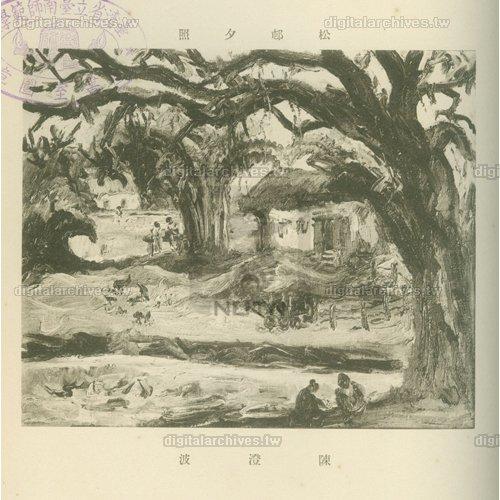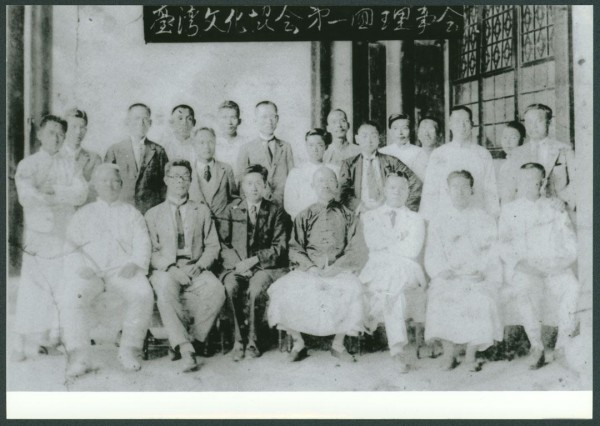TELDAP Collections
| A Portrait of Taiwanese Figures in the Japanese Colonial Period |
|
Lai He Lai He, born on May 28, 1894 in Changhua city, was formerly known as “Lai He” — the same name in English but representing a different meaning in Chinese characters. His original “He” means “river,” while the later “He” means “peace.” He also used many pennames, such as Lan Yun, Fu San, An Dousheng, Hui, and Zou Jiexian. He founded the Lai He Hospital in Changhua at the age of 23. He didn’t practice medicine to get rich; his sympathy for the poor results in his giving free or inexpensive care to low-income households. His first Chinese novel, notable for being written in the vernacular, was named “Dou Nay Nr” and was published in the Taiwan People’s Newspaper in 1926. The novel incorporates the use of dialect and slang, which adds a strong local flavor to the story.
Lai was the chief editor for literary columns in the Taiwan People’s Newspaper, the Taiwan New People’s Newspaper, Nanyin, La Formosa Nov-literaturo, and other publications. His best-known novelettes include A Shaft of “Tsan Tsai”, San Song De Ren Gu Xi, poetry work Song of a Wandering Life, and Southland Dirge. He was a renowned writer in Taiwan during the Japanese colonial period, and a leader in Taiwanese literary circles in the 1930s. Lai participated in the petition campaigns of the Taiwan Cultural Council and Parliament, fighting against colonization. He described the oppressed people using his pen, digging into the lives of Taiwanese commoners at the time. He died on January 31, 1943.
Photograph of the Taiwan Cultural Council’s first Board of Directors meeting; Lai He is second from right in the back row.
(Source: National Tsing Hua University Library)
Huang Tushui
Huang Tushui was born in 1895 in the back alleys of Monga’s Qingshui Temple in Taipei. His father was a rickshaw repairman, so he grew up familiar with the art of carpentry. In 1907 his father passed away, and Huang and his mother relocated to the brother of his mother’s home in Dadaocheng. Near their residence were many temples, incense shops, and Buddhist gift shops. Such an environment, filled with religious art, had a long-term influence on Huang. After graduating from the Daitotei Formosan School at the age of 16, Huang was admitted to the Japanese Normal School, where his wood-carving skills were highly praised by his teachers.
Six months after graduating, he was recommended and sponsored by a Taiwan Governor-General official to study carving at the Tokyo School of Fine Arts. His work “A Mountain Kid Fluting” was selected to be displayed in Japan’s Imperial Exhibition in 1920. The following year, his marble carving “Immortal Water” was again selected for the Imperial Exhibition. When the Fourth Imperial Exhibition selected his work “A Posing Woman,” he became the first Taiwanese sculptor to receive such recognition. Buffalo had a special place in Huang’s creative vocabulary; one of his largest and famous works on buffalo was “Buffalo Group Portrait.” During the creation of this work he fell ill. Due to appendicitis with peritonitis, Huang died on December 21, 1930.
Du Congming (Tu Tsung-ming)
Du Congming was born on August 25, 1893 in Beixin village of Tamsui in Taiwan. He also used the pen name Si Mu. He went to Kyoto Imperial University in Japan in 1915 to study internal medicine, returning to Taiwan in 1922 to be a professor at the Specialist Medical Schools of the Taiwan Governor-General’s Office. On December 16, 1922 he received his M.D., the first Taiwanese ever to be awarded a doctoral degree.
In 1929, he began studying opium and how to treat addiction. In August of that year, he proposed establishing a rehab facility and addiction treatment center to the Taiwan Governor-General Office. He was the first to design the anesthetic urine test, which won him the title—the father of modern urine drug testing. Du also studied the medicinal effects of snake venom in depth, including how to make snake venom into a painkiller. He also found that papaya leaves contain substances that can be extracted to kill dysentery protozoa.
Du was appointed a professor of pharmacology in the Department of Medicine at Taipei Imperial University (now called National Taiwan University,) and was the first professor of Taiwanese ancestry at the university. Du made remarkable advancements in pharmacology, saving countless lives. “Embrace the joy of learning, know the importance of research” was his motto. He died on February 25, 1986 at National Taiwan University Hospital. He is the author of An Anthology of Articles in Pharmacology, Compilation of Publications and Speeches of Professor Dr. Tsungming Tu, and History of Western and Chinese Medicine, among publications.
Chen Chengpo
Chen Chengpo was born in 1895 in Chiayi, Taiwan. Soon after he was born, his mother died, leaving him under the care of his grandmother. Chen was admitted to the No. 1 public school in Chiayi at the age of 13, and began attending the Japanese Normal School when he turned 19, where he was instructed by Ishikawa Kinichiro, who wielded considerable influence over Taiwan’s art circle during the Japanese colonial period. After graduating, he returned to his high school in Chiayi to teach for six years.
At the age of 30, Chen enrolled in the Tokyo School of Fine Arts. His oil painting “Street of Chiayi” (1926) was exhibited at Japan’s Seventh Empire Art Exhibition. The next year, his oil painting “Street Scene on a Summer Day” (1927) was selected for the Eighth Empire Art Exhibition. His work “Longshan Temple” (1928) received first prize at the Taiwan Fine Art Exhibition, and his piece “Early Spring” (1929) was again selected for the Empire Art Exhibition, the third time for him. The same piece was reselected in 1930. In 1934, his “Spring in West Lake” was selected.
In 1928, Chen was invited to teach at the Western Painting Department at Shanghai’s Xinhua School of Art, holding an adjunct position with the Institute of Art gallery teaching Western painting, as well as serving as the director of the Chang Ming College of Arts Normal School. In 1934 he founded the Taiyang Art Association. In 1947 he was involved in the 228 Incident and was executed in front of the Central Fountain of Chiayi.
 Chen Chengpo’s “Sunset over the Pine Village” at the Sixth Taiwan Fine Art Exhibition
(Source: Department of Information and Learning Technology, National University of Tainan)
Deng Yuxian (Teng Yu-hsien)
Deng Yuxian was born in 1906 in Longtan village of Daxi in Taiwan. He moved to Taipei with his father in 1908. In 1925, he graduated from the Governor-General Office’s Taihoku Normal School and became a teacher at the Rixin Public School in Taipei.
Deng married Zhong Youmei in 1926. He left his teaching job and subsequently went to study music in the Tokyo Music Academy in 1929. In 1932, he was signed to Wen Sheng Records, set up by Jiang Tianshou and located in Dadaocheng, Taipei. After Deng joined the company, he composed “March of the Daitotei (Dadaocheng).” In 1933, invited by Chen Junyu, Deng agreed to be signed to Columbia Records. That year, Deng composed several well-known songs, including “Bang Chhun Hong,” “Goat la Chhiu,” and “U Ia Hoe,” among others. Deng resigned from his job and became a teacher at Cyonglin Public School at the age of 35. In 1944, he died from disease at the age of 39.
References:
Hsiung Shih Art Monthly Press (2000), Family Museum of Art: Young lady, Times, Chen Jin, Taipei: Tian Liqing
Hsiung Shih Art Monthly Press (2000), Family Museum of Art: Oil painting, Passion, Chen Chengpo, Taipei: Lin Yuchun
Hsiung Shih Art Monthly Press (2000), Family Museum of Art: The earth, Song of pasturing, Huang Tushui, Taipei: Li Qinxian
Lai He Memorial Hall (1994), Lai He Research Documents Compilation, Volume 2, Changhua: Yang Suqing
Taipei County Cultural Center (1997), Anthology of Works of Writers of Taipei County — Deng Yuxian’s Music and Me, Banciao: Xie Aijie
|













